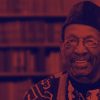
The campaign included 15 photos of Afro-Colombians shot low-key, which yields the entire photo in various shades of black. The man seen in this photo, “the black angel,” in some ways spotlights some of the stereotypes of black men as having vitality, strength and virility.Edgar Garcés
When foreigners think of the country of Colombia, usually visions of drug-cartel bosses and Latin beauty queens with olive skin come to mind. Few foreigners know just how multicultural, and black, the country is. Colombia has the second-largest population of people of African descent in the Americas after Brazil—at least 5 million, according to the country’s census, but likely a far higher number.
“We all come on that same boat,” says Edwin Salcedo, an Afro-Colombian activist and communications consultant. Salcedo is referring to the hundreds of boats that carried at least 1 million captured Africans from the West Coast of Africa to the Colombian city of Cartagena—the largest slave port in the Spanish colonial empire.
Today Cartagena is a majority-black city with a population of more than 800,000 people. But this isn’t reflected in the census. The city is at least 75 percent Afro-Colombian, but only 35 percent of that group self-identifies as Afro-Colombian, Salcedo says. It is commonly believed that at least 25 percent of Colombia’s 48 million people are of African descent, but the census reflects only about 10 percent, or 5 million.
“The question is why? It’s because people don’t want to be treated as black because being black in Cartagena and Colombia at large also means that you are low-income, poor and have poor education,” Salcedo says.
And it also usually doesn’t mean beautiful.
“People often use examples based on black physical appearance to say that something is bad, but if it’s good, it’s an exception, such as, ‘She is black, but she is beautiful,’” says Andry González, a 24-year-old consultant who lives in Cartegena. “It means if you are black, you should be ugly.”
South African anti-apartheid activist Steve Biko popularized the phrase “Black is beautiful” in the 1960s, and then it spread to the U.S. and finally reached Brazil in the ’70s as Ser negro é bonito. Now Salcedo is doing everything in his power to make sure Afro-Colombians claim their blackness and embrace the philosophy of Ser negro es hermoso—“Black is beautiful” in Spanish. Last year he spearheaded the launch of a unique visual and social media campaign—#SerNegroEsHermoso—
“We are in the beginning stage of a self-recognizing society. I thought to have a campaign like this, it would push forward self-recognition and self-esteem and a different aesthetic of being black,” Salcedo says. “It’s a campaign for our own people and the society at large for people to open our minds past stereotypes that are rooted in society.”
Photographer Edgar Garcés shot the campaign in low-key, which renders the entire photo in various shades of black. The 15 portraits portray the diversity of Afro-Colombians through age, sex and size, and they both represent and challenge common characters in Colombian myths: the beauty queen, the virgin, the angel, the fish merchant.

This photo in the campaign is of “the virgin.” In Colombia, virginity is praised as an honor for women. But the virginal woman is rarely depicted as black.Edgar Garcés
In one image, a full-figured woman poses in her underwear with just a crown on her head. She is a queen not because others have crowned her but because she accepts her beauty and views herself as a queen. In another, a bare-chested man sits with his knuckles, all covered in gold rings, in full view. This man is “the godfather” because he protects his family with all of his power.
“I wanted to wrist-slap them and see what their reactions were,” Salcedo says.
As expected with such a bold campaign, many locals had negative reactions. Some people on social media called the campaign racist because of its focus on black people. Others found the photos ugly. But most people praised the campaign.
American teacher George Williams was so inspired that he started using the hashtag to create his own #SerNegroEsHermoso images on Instagram.
“I love how unapologetically black and negro the campaign was. It’s about the raw, natural and primitive form of humanity,” Williams says. “I took on the idea, and I started writing different narratives about being black and being beautiful.”
When the campaign launched in August, it was only supposed to last a month. But the owners of the advertising space decided to leave it up, so visitors to Cartagena can still see the images throughout the city. Unfortunately, Salcedo won’t know how successful the #SerNegroEsHermoso campaign is until the end of the decade. In 2017 Colombia will launch another national census, and he’s hoping that more people will self-declare as Afro-Colombian in Cartagena.
Kiratiana Freelon is a Rio de Janeiro-based multimedia journalist whose work focuses on social issues, international news and sporting events. She has published two books: one a travel guide to black Paris, and the other a travel guide to multicultural London. Visit her blog and follow her on Twitter.















